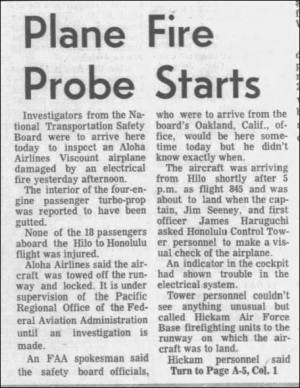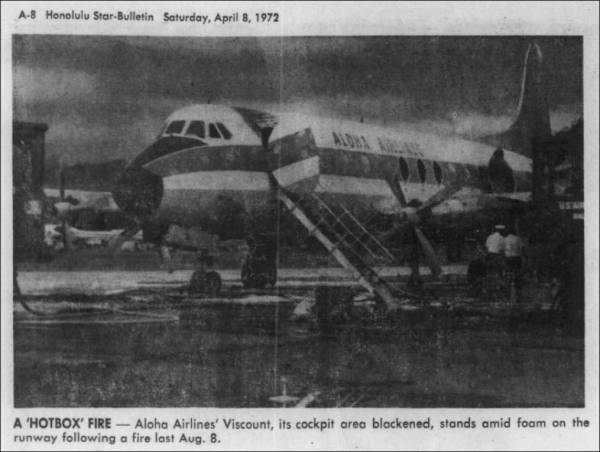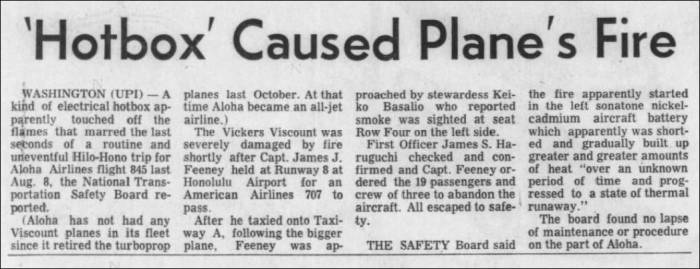Fire On Board Aloha Airlines Flight 845
On August 8, 1971, a Vickers Viscount 745D, N7415, operating as Flight 845 from Hilo, landed at Honolulu Airport at 1724 hours. The flight had departed Hilo at 1630, Hawaii Standard time.
During the landing roll (after the plane touched down) the captain noticed an unusual odor. He and the First Officer attributed the odor to engine fumes coming from the fresh air inlet as a result of a quartering tailwind. They decided to turn off the circulation fan. Soon afterward, a stewardess notified the captain of smoke in the vicinity of seat row 4, on the left side of the aircraft. The first officer checked the cabin and confirmed that there was a presence of smoke.
At 1727:30, the crew requested ground control to check the right side of the aircraft for smoke. Before receiving a reply, Flight 845 transmitted, “Shutting down, bring out the fire stuff.”
The captain stopped the aircraft, shut down the engines and turned off all electrical switches.
The first officer was directed to the bottom of the stairs in order to direct the passengers away from the aircraft and the rotating propellers. (Propellers require spool-down time and were still rotating).
As the captain was leaving his seat, he noticed he could move his control wheel to the full aft position, despite the control lock having been engaged following the landing rollout, approximately two minutes earlier.
Once all passengers had been evacuated, the Captain entered the cabin of the aircraft and noticed the area was partially filled with smoke, but did not notice any fire.
After the captain had deplaned, eleven pieces of firefighting equipment arrived and dispensed 165 gallons of foam liquid, 1,500 pounds of CO2, and approximately 3,600 gallons of water in order to control the fire.
Page 4 of the National Transportation Safety Board (NTSB) Report states: “The aircraft interior was severely damaged by fire, heat and smoke. The most severe fire and heat damage existed in the passenger compartment in the vicinity of seat row 4. The intensity of damage throughout the cabin was more extensive at the ceiling level than on the lower side wall structure. The area below seat 4B had a hole about 21 by 31 inches burned through the wood floor. The left aircraft battery tray located in the electrical compartment directly below the hole was visible. The left nickel-cadmium battery, while in a smoldering state, was removed from the tray by a company mechanic during the final phase of the firefighting, approximately ten minutes after smoke was first detected onboard the aircraft. Damage to the area below the cabin floor was limited to the left side of the electrical compartment located directly below seat row 4. That portion of the aileron, elevator, and rudder control push rods (approximately 16 inches) located about 11.5 inches above the left battery had melted away, as did three floor support stringers. Fuel and hydraulic systems showed no evidence of system leakage which could have fueled the fire. The Sonatone nickel-cadmium battery, Type CA-20H, which had been removed from the left side of the aircraft, was examined. The battery was severely charred and discolored by heat and fire. The polystyrene cell case material had melted and solidified in the bottom of the battery case. A solidified flow pattern of this material through the battery case viewing ports was also evident. All external battery case damage was above these viewing ports. The battery on the right side, a Marathon nickel-cadmium, Type CA 20-H, which contained nylon cell cases was subjected to detailed shop inspection and tests. The battery was found to be in a state of complete discharge. However, this battery recovered full charge after a deep cycle process as recommended by the manufacturer. Electrical tests conducted on the aircraft wiring and electrical generating system disclosed no malfunction or failures except those failures attributable to heat and fire. The near complete destruction of the nickel-cadmium battery installed on the left side precludes a determination of the mechanics of the internal failure which resulted in a thermal runaway. A thermal runaway is a condition in which a battery on constant-potential charge at elevated temperature destroys itself due to internal heat generation which is caused by the high overcharge currents in constant-potential charging. These high currents increase the battery temperature, causing higher currents, in turn resulting in higher temperatures and even higher currents, ending in destruction of the battery.”
From Page 6 of the NTSB report regarding Aloha Flight 845: “The air circulation pattern when the aircraft's pressurization system is in operation makes it difficult to determine the time that the battery malfunction began. The pressurization system in this aircraft forces air from the cabin into the baggage compartment, aft through the electrical and hydraulic compartments, then overboard through the outflow valves located in the aft underside of the aircraft. Smoke or fumes originating in the batteries during flight would dump overboard through normal air circulation and the odor would not enter the cockpit until after the aircraft had landed and the cabin pressurization system spill valves were opened. In this case, the crew smelled a burning odor while the recirculating fan was on after landing; however, when the fan was turned off the odor dissipated… …The exact time of the initial battery malfunction cannot be ascertained; however, the flight control push rods located a short distance above the left battery had not been burned through at the time the flight control lock was engaged following the landing rollout. Control lock engagement in this aircraft is made at the flight control surfaces, and control yoke movement from the forward position (normal position following runway touch down) to the neutral (engage) position was necessary before engagement could be made. Therefore, the flight control push rods were burned and melted by fire originating from the left hand battery between the time the aircraft was turned from the landing runway and the time the captain assisted himself out of the iris seat by pulling on the locked control yoke. The elapsed time between these two occurrences was approximately 2 minutes, which attests to the extreme intensity of the battery fire.”
United Flight 823 a Vickers Viscount 745D, N7405, sustained fire damage-while in flight- beneath the left side No. 4 window prior to crashing at Parrottsville, according to the official CAB Report.
In 1971, Aloha Airlines Flight 845 also a Vickers Viscount 745D, N7415 caught fire on the runway at Honolulu airport when the left side nickel cadmium battery beneath the passenger cabin floor was destroyed by what is described as a “thermal runaway”.
The CAB report (Page 14) for United 823 dismissed the possibility of a fire occurring in the cargo hold using the reasoning that a fire would have burned through the relatively thin skin of the fuselage. A catastrophic fire would have then left a trail of partially burned debris in the flight path's wake. Since very little debris was found as the aircraft approached the Parrottsville crash site, the CAB ruled out a fire originating below the floor of the passenger cabin.
The Aloha Flight 845 fire was ruled to have begun below the cabin floor, in the same area that sustained heavy fire damage on United Flight 823-Seat Row 4.
To be exact, Page 4 of the 1972 NTSB report regarding Aloha Flight 845 describes the area below Seat 4B as having a hole 21 by 31 inches burned into the wooden floor. Also on page 4 of that report it is stated: “The intensity of damage throughout the cabin was more extensive at the ceiling level than on the lower side wall structure.”
No mention is made that Aloha Flight 845 sustained any fire damage to the underside of the aircraft's fuselage.
As a result of the fire on board Aloha Flight, Airworthiness Directive 71-21-5 and Advisory Circular AC 00-33 were issued.




